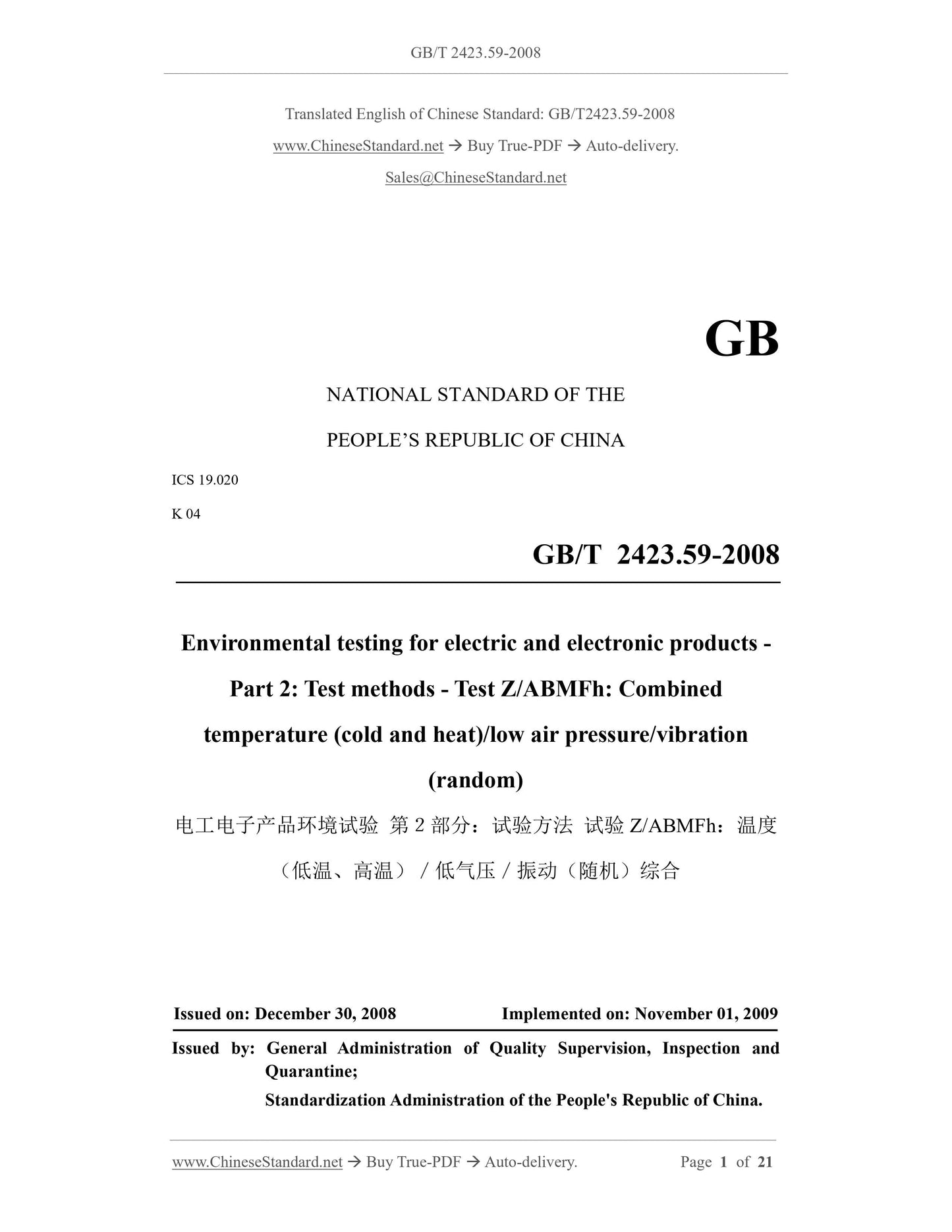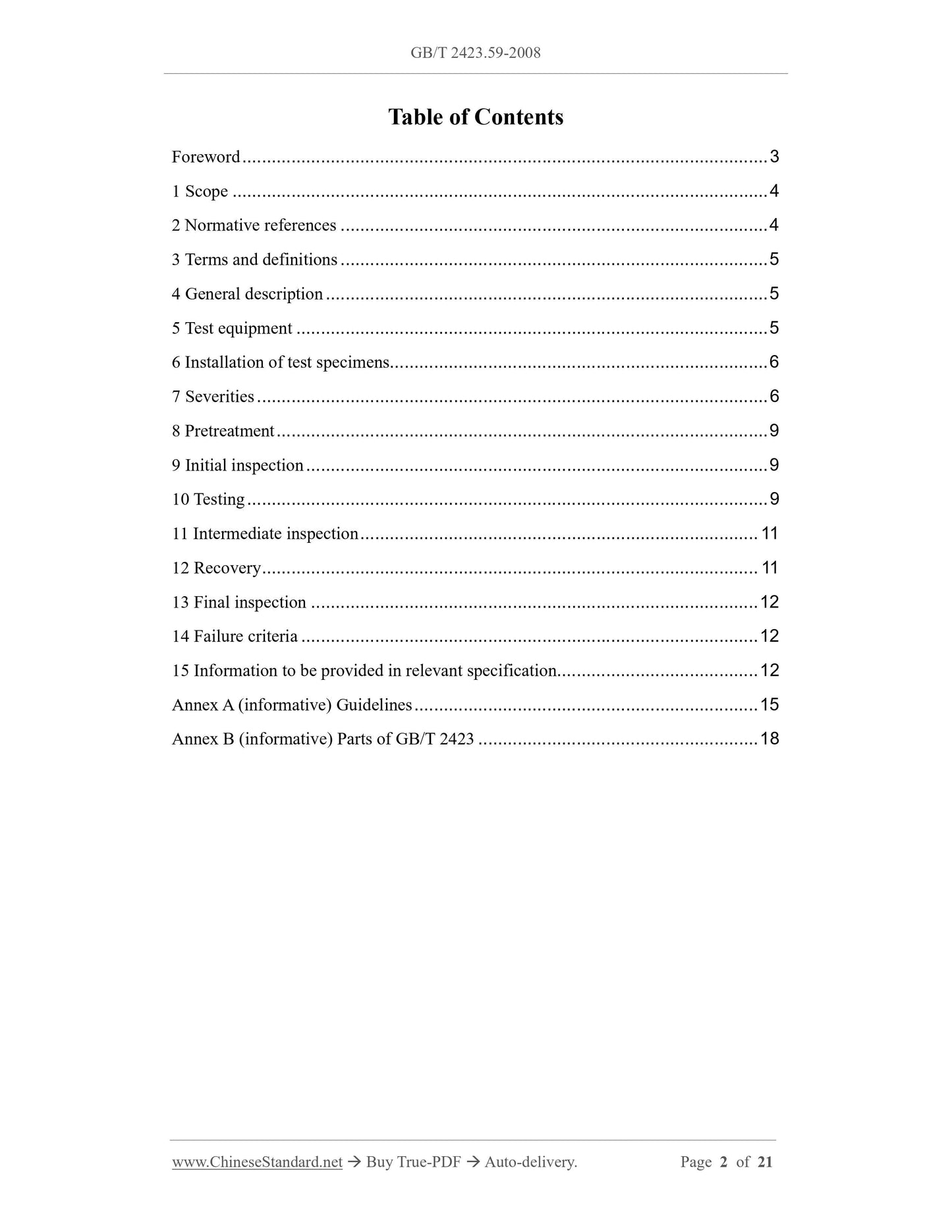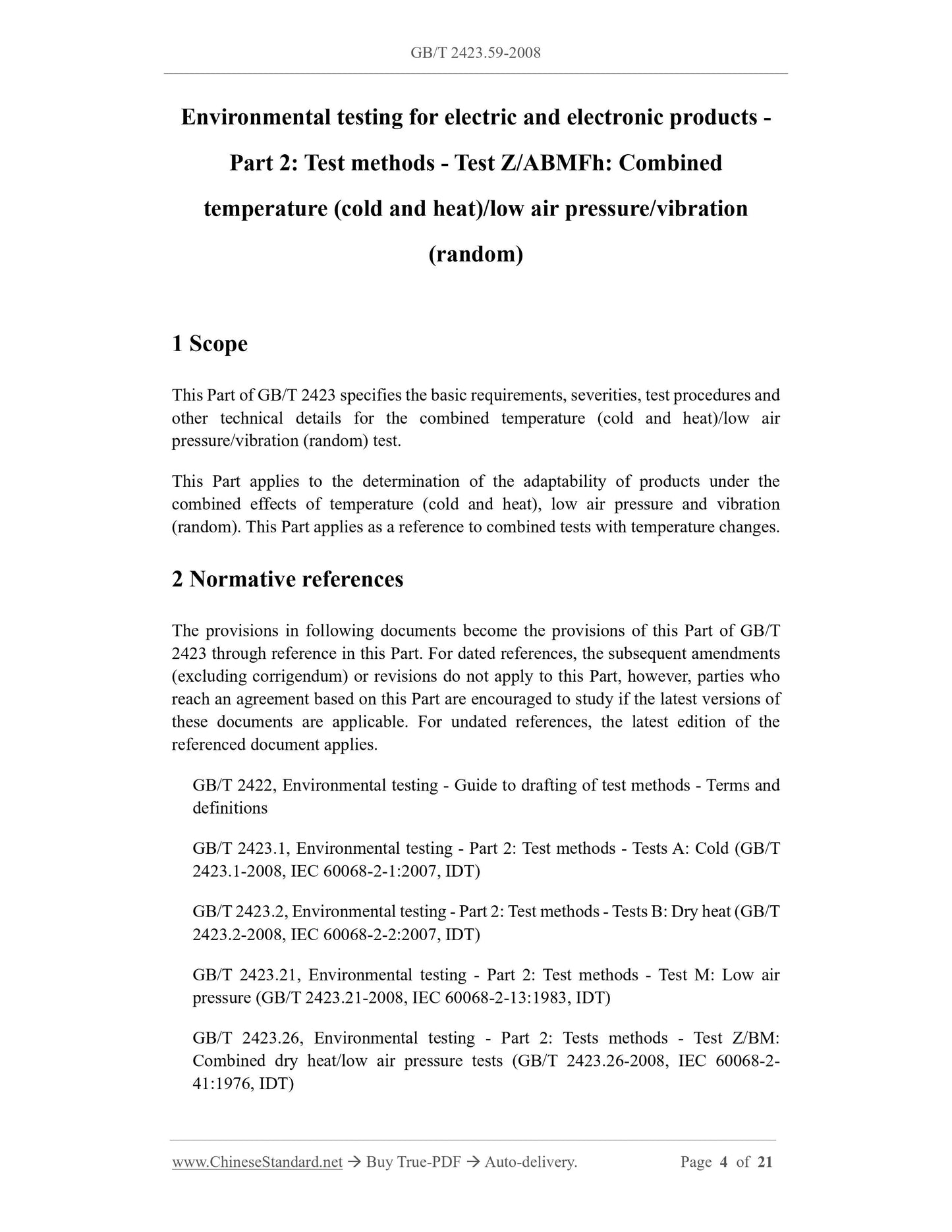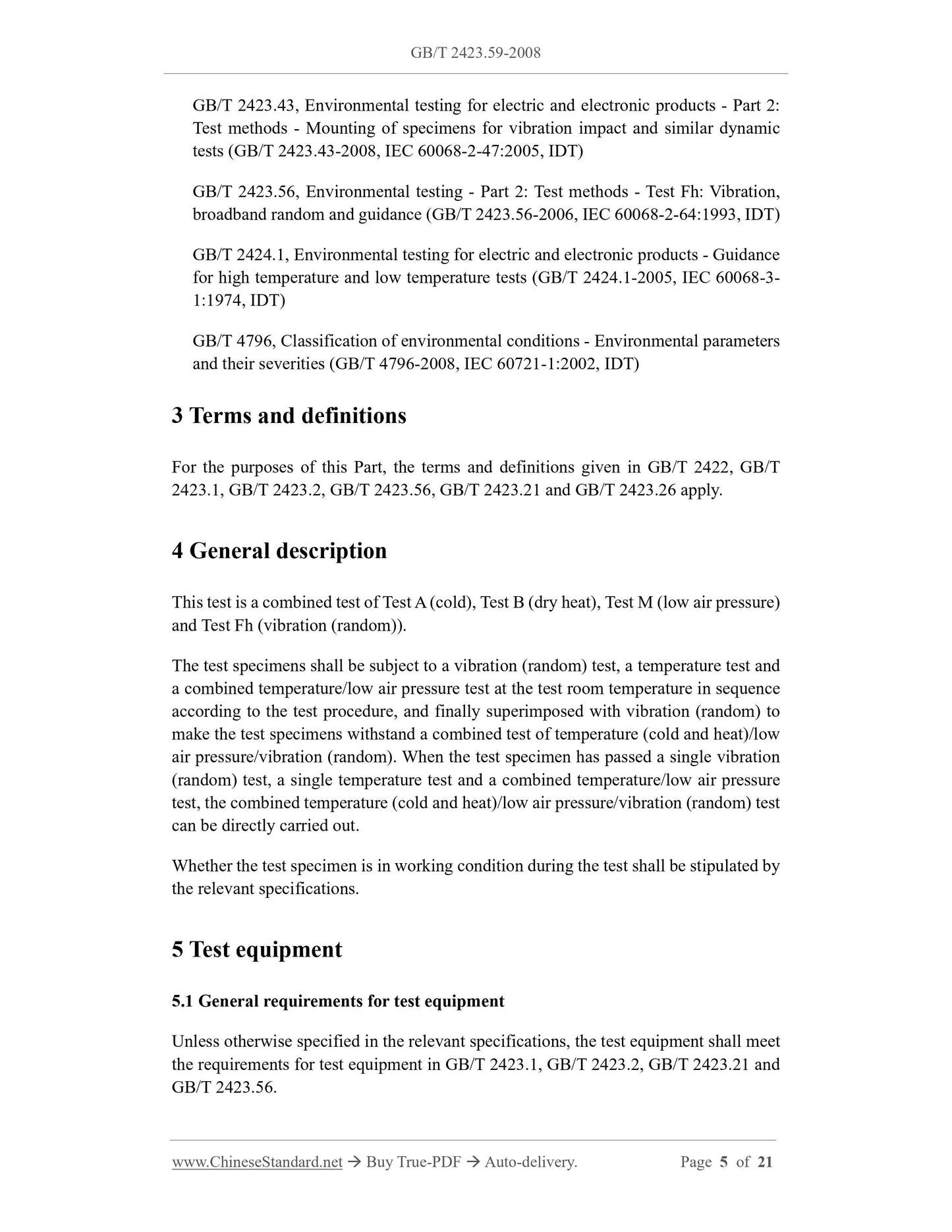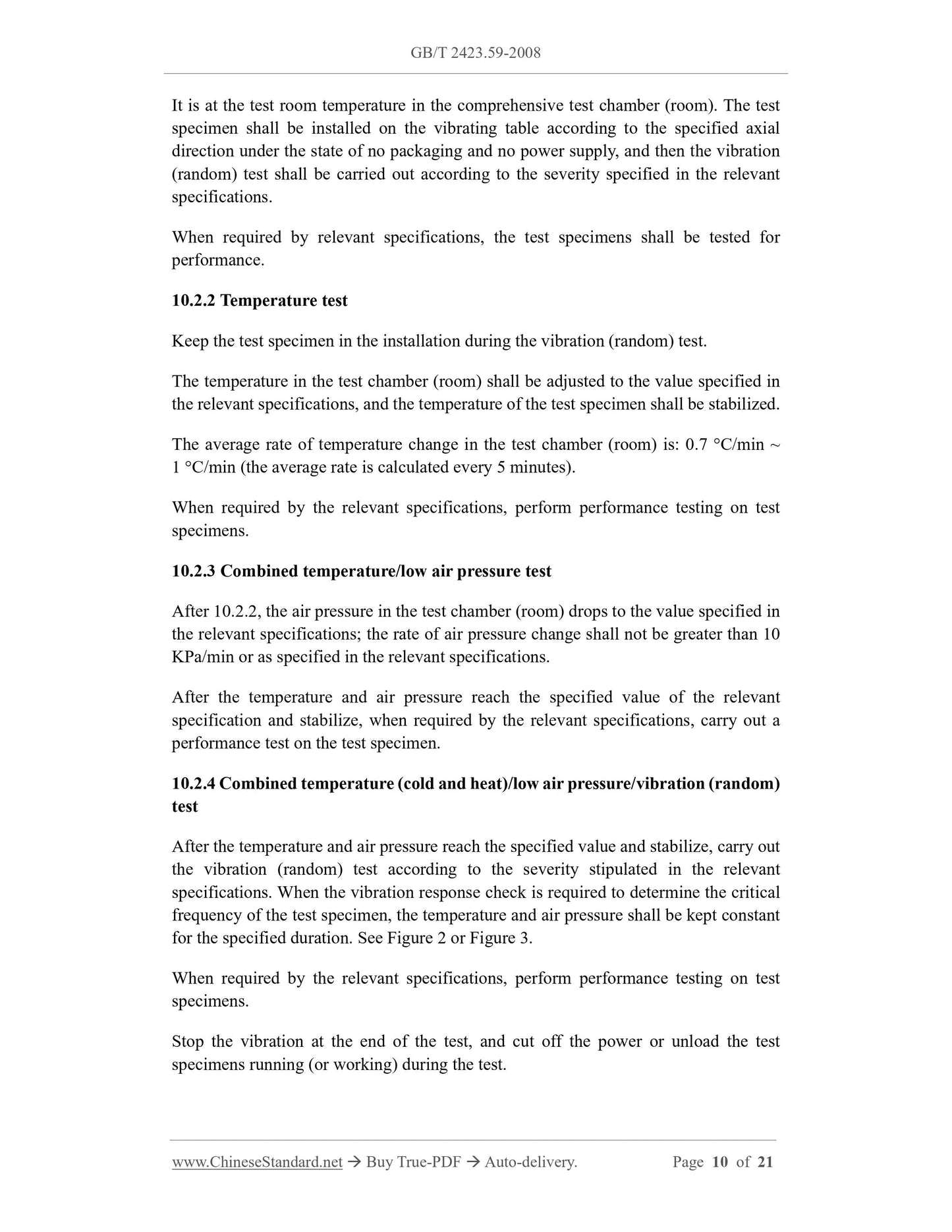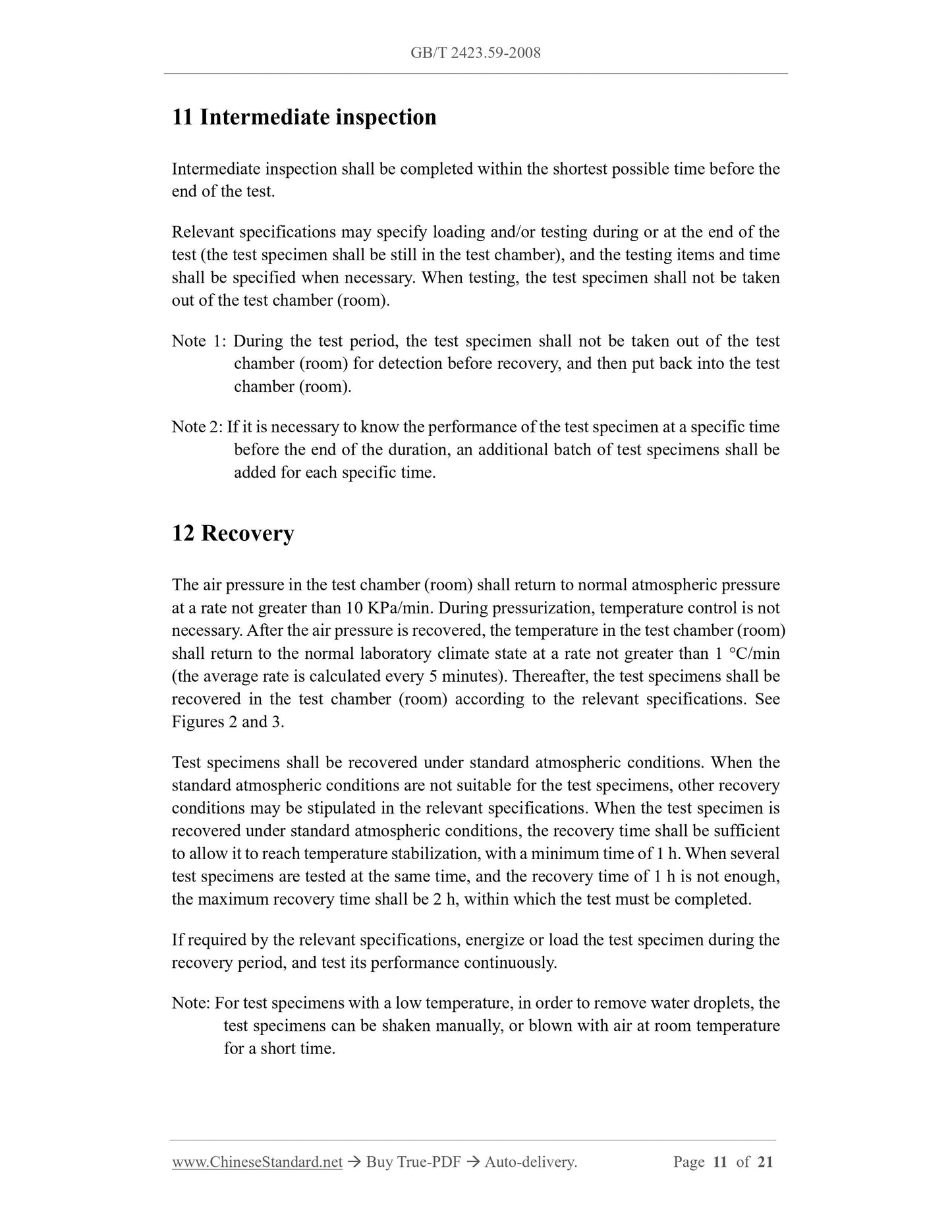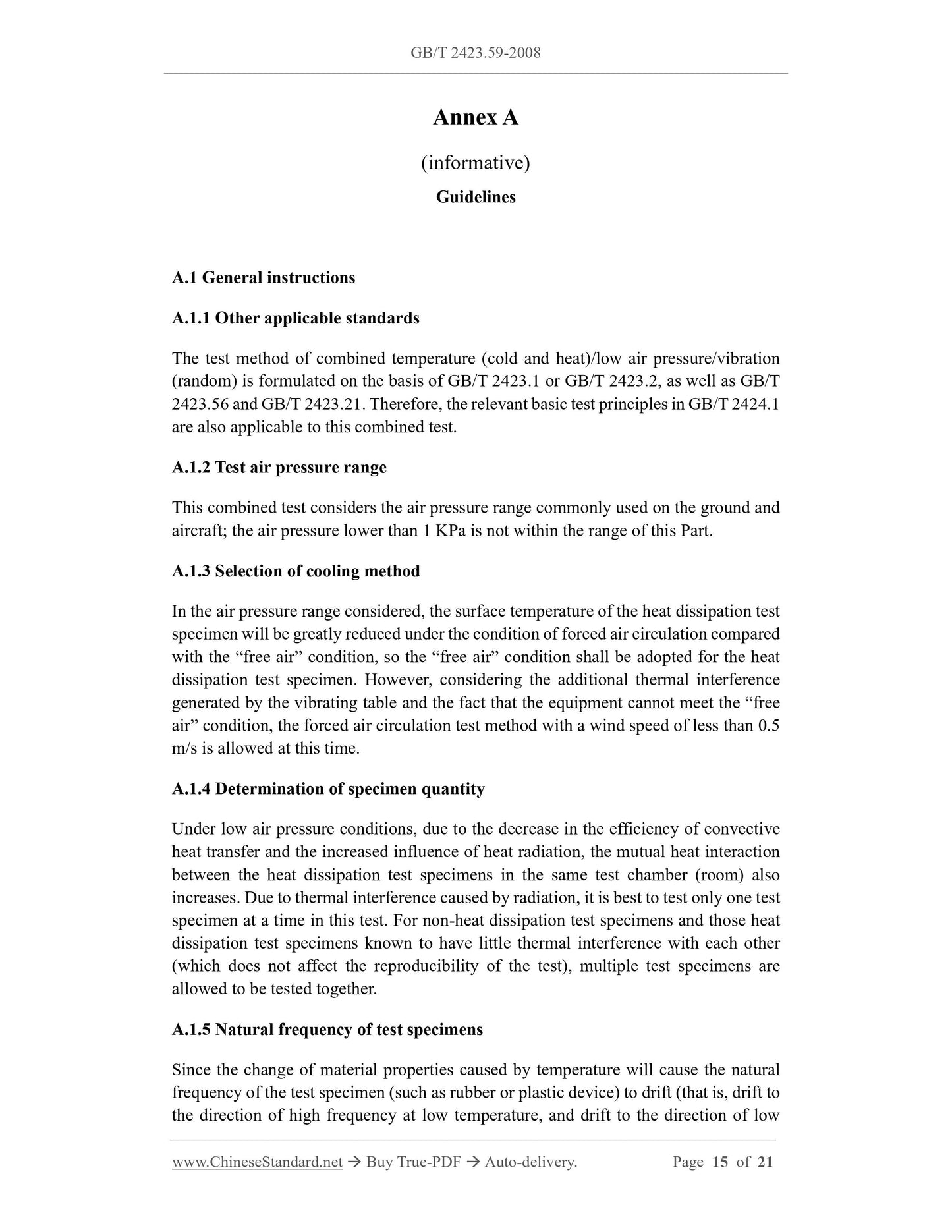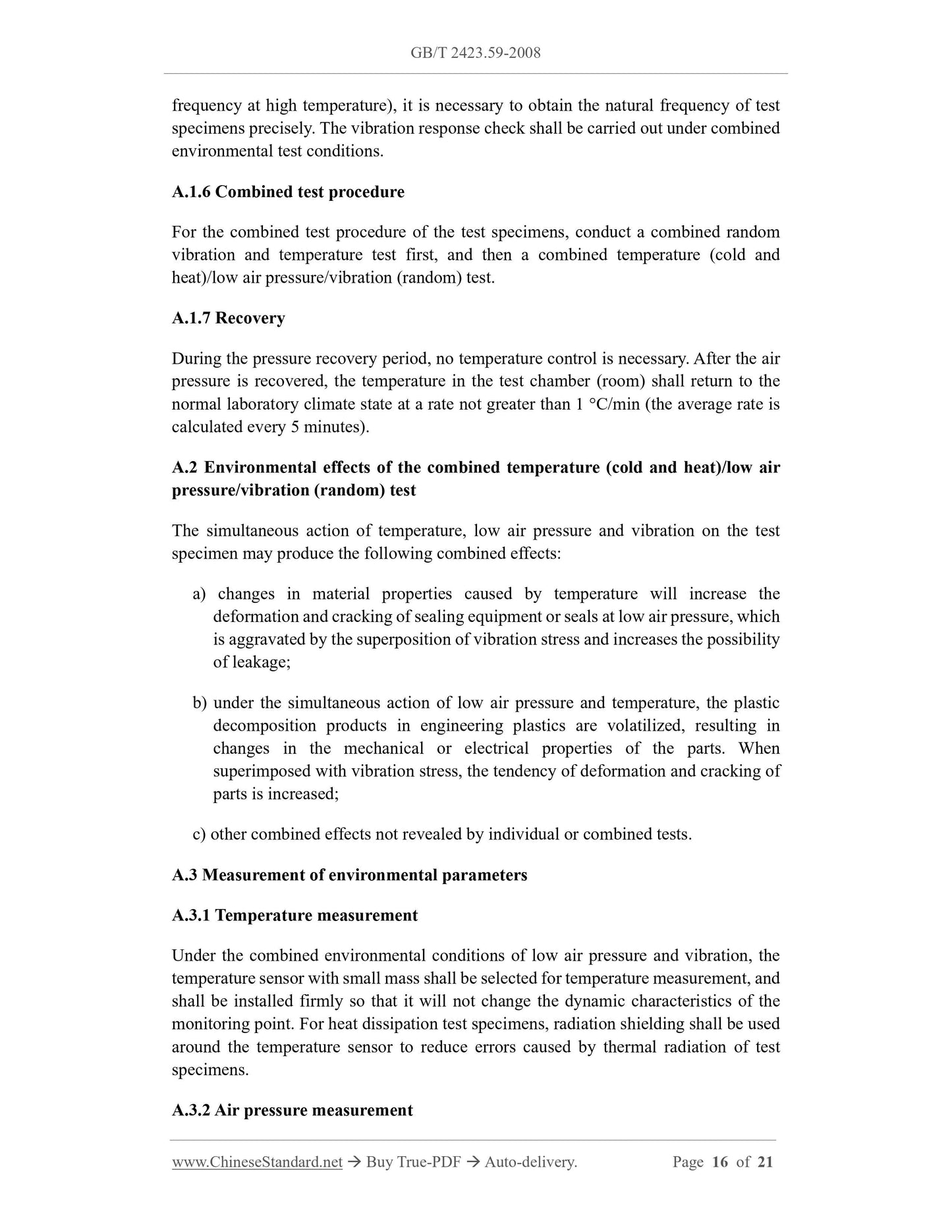1
/
of
8
www.ChineseStandard.us -- Field Test Asia Pte. Ltd.
GB/T 2423.59-2008 English PDF (GB/T2423.59-2008)
GB/T 2423.59-2008 English PDF (GB/T2423.59-2008)
Regular price
$280.00
Regular price
Sale price
$280.00
Unit price
/
per
Shipping calculated at checkout.
Couldn't load pickup availability
GB/T 2423.59-2008: Environmental testing - Part 2: Test methods - Test Z/ABMFh: Combined temperature (cold and heat) / low air pressure / vibration (random)
Delivery: 9 seconds. Download (& Email) true-PDF + Invoice.
Get Quotation: Click GB/T 2423.59-2008 (Self-service in 1-minute)
Historical versions (Master-website): GB/T 2423.59-2008
Preview True-PDF (Reload/Scroll-down if blank)
GB/T 2423.59-2008
GB
NATIONAL STANDARD OF THE
PEOPLE’S REPUBLIC OF CHINA
ICS 19.020
K 04
Environmental testing for electric and electronic products -
Part 2: Test methods - Test Z/ABMFh: Combined
temperature (cold and heat)/low air pressure/vibration
(random)
ISSUED ON: DECEMBER 30, 2008
IMPLEMENTED ON: NOVEMBER 01, 2009
Issued by: General Administration of Quality Supervision, Inspection and
Quarantine;
Standardization Administration of the People's Republic of China.
Table of Contents
Foreword ... 3
1 Scope ... 4
2 Normative references ... 4
3 Terms and definitions ... 5
4 General description ... 5
5 Test equipment ... 5
6 Installation of test specimens ... 6
7 Severities ... 6
8 Pretreatment ... 9
9 Initial inspection ... 9
10 Testing ... 9
11 Intermediate inspection ... 11
12 Recovery ... 11
13 Final inspection ... 12
14 Failure criteria ... 12
15 Information to be provided in relevant specification... 12
Annex A (informative) Guidelines ... 15
Annex B (informative) Parts of GB/T 2423 ... 18
Environmental testing for electric and electronic products -
Part 2: Test methods - Test Z/ABMFh: Combined
temperature (cold and heat)/low air pressure/vibration
(random)
1 Scope
This Part of GB/T 2423 specifies the basic requirements, severities, test procedures and
other technical details for the combined temperature (cold and heat)/low air
pressure/vibration (random) test.
This Part applies to the determination of the adaptability of products under the
combined effects of temperature (cold and heat), low air pressure and vibration
(random). This Part applies as a reference to combined tests with temperature changes.
2 Normative references
The provisions in following documents become the provisions of this Part of GB/T
2423 through reference in this Part. For dated references, the subsequent amendments
(excluding corrigendum) or revisions do not apply to this Part, however, parties who
reach an agreement based on this Part are encouraged to study if the latest versions of
these documents are applicable. For undated references, the latest edition of the
referenced document applies.
GB/T 2422, Environmental testing - Guide to drafting of test methods - Terms and
definitions
GB/T 2423.1, Environmental testing - Part 2: Test methods - Tests A: Cold (GB/T
2423.1-2008, IEC 60068-2-1:2007, IDT)
GB/T 2423.2, Environmental testing - Part 2: Test methods - Tests B: Dry heat (GB/T
2423.2-2008, IEC 60068-2-2:2007, IDT)
GB/T 2423.21, Environmental testing - Part 2: Test methods - Test M: Low air
pressure (GB/T 2423.21-2008, IEC 60068-2-13:1983, IDT)
GB/T 2423.26, Environmental testing - Part 2: Tests methods - Test Z/BM:
Combined dry heat/low air pressure tests (GB/T 2423.26-2008, IEC 60068-2-
41:1976, IDT)
GB/T 2423.43, Environmental testing for electric and electronic products - Part 2:
Test methods - Mounting of specimens for vibration impact and similar dynamic
tests (GB/T 2423.43-2008, IEC 60068-2-47:2005, IDT)
GB/T 2423.56, Environmental testing - Part 2: Test methods - Test Fh: Vibration,
broadband random and guidance (GB/T 2423.56-2006, IEC 60068-2-64:1993, IDT)
GB/T 2424.1, Environmental testing for electric and electronic products - Guidance
for high temperature and low temperature tests (GB/T 2424.1-2005, IEC 60068-3-
1:1974, IDT)
GB/T 4796, Classification of environmental conditions - Environmental parameters
and their severities (GB/T 4796-2008, IEC 60721-1:2002, IDT)
3 Terms and definitions
For the purposes of this Part, the terms and definitions given in GB/T 2422, GB/T
2423.1, GB/T 2423.2, GB/T 2423.56, GB/T 2423.21 and GB/T 2423.26 apply.
4 General description
This test is a combined test of Test A (cold), Test B (dry heat), Test M (low air pressure)
and Test Fh (vibration (random)).
The test specimens shall be subject to a vibration (random) test, a temperature test and
a combined temperature/low air pressure test at the test room temperature in sequence
according to the test procedure, and finally superimposed with vibration (random) to
make the test specimens withstand a combined test of temperature (cold and heat)/low
air pressure/vibration (random). When the test specimen has passed a single vibration
(random) test, a single temperature test and a combined temperature/low air pressure
test, the combined temperature (cold and heat)/low air pressure/vibration (random) test
can be directly carried out.
Whether the test specimen is in working condition during the test shall be stipulated by
the relevant specifications.
5 Test equipment
5.1 General requirements for test equipment
Unless otherwise specified in the relevant specifications, the test equipment shall meet
the requirements for test equipment in GB/T 2423.1, GB/T 2423.2, GB/T 2423.21 and
GB/T 2423.56.
It is at the test room temperature in the comprehensive test chamber (room). The test
specimen shall be installed on the vibrating table according to the specified axial
direction under the state of no packaging and no power supply, and then the vibration
(random) test shall be carried out according to the severity specified in the relevant
specifications.
When required by relevant specifications, the test specimens shall be tested for
performance.
10.2.2 Temperature test
Keep the test specimen in the installation during the vibration (random) test.
The temperature in the test chamber (room) shall be adjusted to the value specified in
the relevant specifications, and the temperature of the test specimen shall be stabilized.
The average rate of temperature change in the test chamber (room) is: 0.7 °C/min ~
1 °C/min (the average rate is calculated every 5 minutes).
When required by the relevant specifications, perform performance testing on test
specimens.
10.2.3 Combined temperature/low air pressure test
After 10.2.2, the air pressure in the test chamber (room) drops to the value specified in
the relevant specifications; the rate of air pressure change shall not be greater than 10
KPa/min or as specified in the relevant specifications.
After the temperature and air pressure reach the specified value of the relevant
specification and stabilize, when required by the relevant specifications, carry out a
performance test on the test specimen.
10.2.4 Combined temperature (cold and heat)/low air pressure/vibration (random)
test
After the temperature and air pressure reach the specified value and stabilize, carry out
the vibration (random) test according to the severity stipulated in the relevant
specifications. When the vibration response check is required to determine the critical
frequency of the test specimen, the temperature and air pressure shall be kept constant
for the specified duration. See Figure 2 or Figure 3.
When required by the relevant specifications, perform performance testing on test
specimens.
Stop the vibration at the end of the test, and cut off the power or unload the test
specimens running (or working) during the test.
11 Intermediate inspection
Intermediate inspection shall be completed within the shortest possible time before the
end of the test.
Relevant specifications may specify loading and/or testing during or at the end of the
test (the test specimen shall be still in the test chamber), and the testing items and time
shall be specified when necessary. When testing, the test specimen shall not be taken
out of the test chamber (room).
Note 1: During the test period, the test specimen shall not be taken out of the test
chamber (room) for detection before recovery, and then put back into the test
chamber (room).
Note 2: If it is necessary to know the performance of the test specimen at a specific time
before the end of the duration, an additional batch of test specimens shall be
added for each specific time.
12 Recovery
The air pressure in the test chamber (room) shall return to normal atmospheric pressure
at a rate not greater than 10 KPa/min. During pressurization, temperature control is not
necessary. After the air pressure is recovered, the temperature in the test chamber (room)
shall return to the normal laboratory climate state at a rate not greater than 1 °C/min
(the average rate is calculated every 5 minutes). Thereafter, the test specimens shall be
recovered in the test chamber (room) according to the relevant specifications. See
Figures 2 and 3.
Test specimens shall be recovered under standard atmospheric conditions. When the
standard atmospheric conditions are not suitable for the test specimens, other recovery
conditions may be stipulated in the relevant specifications. When the test specimen is
recovered under standard atmospheric conditions, the recovery time shall be sufficient
to allow it to reach temperature stabilization, with a minimum time of 1 h. When several
test specimens are tested at the same time, and the recovery time of 1 h is not enough,
the maximum recovery time shall be 2 h, within which the test must be completed.
If required by the relevant specifications, energize or load the test specimen during the
recovery period, and test its performance continuously.
Note: For test specimens with a low temperature, in order to remove water droplets, the
test specimens can be shaken manually, or blown with air at room temperature
for a short time.
Annex A
(informative)
Guidelines
A.1 General instructions
A.1.1 Other applicable standards
The test method of combined temperature (cold and heat)/low air pressure/vibration
(random) is formulated on the basis of GB/T 2423.1 or GB/T 2423.2, as well as GB/T
2423.56 and GB/T 2423.21. Therefore, the relevant basic test principles in GB/T 2424.1
are also applicable to this combined test.
A.1.2 Test air pressure range
This combined test considers the air pressure range commonly used on the ground and
aircraft; the air pressure lower than 1 KPa is not within the range of this Part.
A.1.3 Selection of cooling method
In the air pressure range considered, the surface temperature of the heat dissipation test
specimen will be greatly reduced under the condition of forced air circulation compared
with the “free air” condition, so the “free air” condition shall be adopted for the heat
dissipation test specimen. However, considering the additional thermal interference
generated by the vibrating table and the fact that the equipment cannot meet the “free
air” condition, the forced air circulation test method with a wind speed of less than 0.5
m/s is allowed at this time.
A.1.4 Determination of specimen quantity
Under low air pressure conditions, due to the decrease in the efficiency of convective
heat transfer and the increased influence of heat radiation, the mutual heat interaction
between the heat dissipation test specimens in the same test chamber (room) also
increases. Due to thermal interference caused by radiation, it is best to test only one test
specimen at a time in this test. For non-heat dissipation test specimens and those heat
dissipation test specimens known to have little thermal interference with each other
(which does not affect the reproducibility of the test), multiple test specimens are
allowed to be tested together.
A.1.5 Natural frequency of test specimens
Since the change of material properties caused by temperature will cause the natural
frequency of the test specimen (such as rubber or plastic device) to drift (that is, drift to
the direction of high frequency at low temperature, and drift to the direction of low
frequency at high temperature), it is necessary to obtain the natural frequency of test
specimens precisely. The vibration response check shall be carried out under combined
environmental test conditions.
A.1.6 Combined test procedure
For the combined test procedure of the test specimens, conduct a combined random
vibration and temperature test first, and then a combined temperature (cold and
heat)/low air pressure/vibration (random) test.
A.1.7 Recovery
During the pressure recovery period, no temperature control is necessary. After the air
pressure is recovered, the temperature in the test chamber (room) shall return to the
normal laboratory climate state at a rate not greater than 1 °C/min (the average rate is
calculated every 5 minutes).
A.2 Environmental effects of the combined temperature (cold and heat)/low air
pressure/vibration (random) test
The simultaneous action of temperature, low air pressure and vibration on the test
specimen may produce the following combined effects:
a) changes in material properties caused by temperature will increase the
deformation and cracking of sealing equipment or seals at low air pressure, which
is aggravated by the superposition of vibration stress and increases the possibility
of leakage;
b) under the simultaneous action of low air pressure and temperature, the plastic
decomposition products in engineering plastics are volatilized, resulting in
changes in the mechanical or electrical properties of the parts. When
superimposed with vibration stress, the tendency of deformation and cracking of
parts is increased;
c) other combined effects not revealed by individual or combined tests.
A.3 Measurement of environmental parameters
A.3.1 Temperature measurement
Under the combined environmental conditions of low air pressure and vibration, the
temperature sensor with small mass shall be selected for temperature measurement, and
shall be installed firmly so that it will not change the dynamic characteristics of the
monitoring point. For heat dissipation test specimens, radiation shielding shall be used
around the temperature sensor to reduce errors caused by thermal radiation of test
specimens.
A.3.2 Air pressure measurement
GB/T 2423.59-2008
GB
NATIONAL STANDARD OF THE
PEOPLE’S REPUBLIC OF CHINA
ICS 19.020
K 04
Environmental testing for electric and electronic products -
Part 2: Test methods - Test Z/ABMFh: Combined
temperature (cold and heat)/low air pressure/vib...
Delivery: 9 seconds. Download (& Email) true-PDF + Invoice.
Get Quotation: Click GB/T 2423.59-2008 (Self-service in 1-minute)
Historical versions (Master-website): GB/T 2423.59-2008
Preview True-PDF (Reload/Scroll-down if blank)
GB/T 2423.59-2008
GB
NATIONAL STANDARD OF THE
PEOPLE’S REPUBLIC OF CHINA
ICS 19.020
K 04
Environmental testing for electric and electronic products -
Part 2: Test methods - Test Z/ABMFh: Combined
temperature (cold and heat)/low air pressure/vibration
(random)
ISSUED ON: DECEMBER 30, 2008
IMPLEMENTED ON: NOVEMBER 01, 2009
Issued by: General Administration of Quality Supervision, Inspection and
Quarantine;
Standardization Administration of the People's Republic of China.
Table of Contents
Foreword ... 3
1 Scope ... 4
2 Normative references ... 4
3 Terms and definitions ... 5
4 General description ... 5
5 Test equipment ... 5
6 Installation of test specimens ... 6
7 Severities ... 6
8 Pretreatment ... 9
9 Initial inspection ... 9
10 Testing ... 9
11 Intermediate inspection ... 11
12 Recovery ... 11
13 Final inspection ... 12
14 Failure criteria ... 12
15 Information to be provided in relevant specification... 12
Annex A (informative) Guidelines ... 15
Annex B (informative) Parts of GB/T 2423 ... 18
Environmental testing for electric and electronic products -
Part 2: Test methods - Test Z/ABMFh: Combined
temperature (cold and heat)/low air pressure/vibration
(random)
1 Scope
This Part of GB/T 2423 specifies the basic requirements, severities, test procedures and
other technical details for the combined temperature (cold and heat)/low air
pressure/vibration (random) test.
This Part applies to the determination of the adaptability of products under the
combined effects of temperature (cold and heat), low air pressure and vibration
(random). This Part applies as a reference to combined tests with temperature changes.
2 Normative references
The provisions in following documents become the provisions of this Part of GB/T
2423 through reference in this Part. For dated references, the subsequent amendments
(excluding corrigendum) or revisions do not apply to this Part, however, parties who
reach an agreement based on this Part are encouraged to study if the latest versions of
these documents are applicable. For undated references, the latest edition of the
referenced document applies.
GB/T 2422, Environmental testing - Guide to drafting of test methods - Terms and
definitions
GB/T 2423.1, Environmental testing - Part 2: Test methods - Tests A: Cold (GB/T
2423.1-2008, IEC 60068-2-1:2007, IDT)
GB/T 2423.2, Environmental testing - Part 2: Test methods - Tests B: Dry heat (GB/T
2423.2-2008, IEC 60068-2-2:2007, IDT)
GB/T 2423.21, Environmental testing - Part 2: Test methods - Test M: Low air
pressure (GB/T 2423.21-2008, IEC 60068-2-13:1983, IDT)
GB/T 2423.26, Environmental testing - Part 2: Tests methods - Test Z/BM:
Combined dry heat/low air pressure tests (GB/T 2423.26-2008, IEC 60068-2-
41:1976, IDT)
GB/T 2423.43, Environmental testing for electric and electronic products - Part 2:
Test methods - Mounting of specimens for vibration impact and similar dynamic
tests (GB/T 2423.43-2008, IEC 60068-2-47:2005, IDT)
GB/T 2423.56, Environmental testing - Part 2: Test methods - Test Fh: Vibration,
broadband random and guidance (GB/T 2423.56-2006, IEC 60068-2-64:1993, IDT)
GB/T 2424.1, Environmental testing for electric and electronic products - Guidance
for high temperature and low temperature tests (GB/T 2424.1-2005, IEC 60068-3-
1:1974, IDT)
GB/T 4796, Classification of environmental conditions - Environmental parameters
and their severities (GB/T 4796-2008, IEC 60721-1:2002, IDT)
3 Terms and definitions
For the purposes of this Part, the terms and definitions given in GB/T 2422, GB/T
2423.1, GB/T 2423.2, GB/T 2423.56, GB/T 2423.21 and GB/T 2423.26 apply.
4 General description
This test is a combined test of Test A (cold), Test B (dry heat), Test M (low air pressure)
and Test Fh (vibration (random)).
The test specimens shall be subject to a vibration (random) test, a temperature test and
a combined temperature/low air pressure test at the test room temperature in sequence
according to the test procedure, and finally superimposed with vibration (random) to
make the test specimens withstand a combined test of temperature (cold and heat)/low
air pressure/vibration (random). When the test specimen has passed a single vibration
(random) test, a single temperature test and a combined temperature/low air pressure
test, the combined temperature (cold and heat)/low air pressure/vibration (random) test
can be directly carried out.
Whether the test specimen is in working condition during the test shall be stipulated by
the relevant specifications.
5 Test equipment
5.1 General requirements for test equipment
Unless otherwise specified in the relevant specifications, the test equipment shall meet
the requirements for test equipment in GB/T 2423.1, GB/T 2423.2, GB/T 2423.21 and
GB/T 2423.56.
It is at the test room temperature in the comprehensive test chamber (room). The test
specimen shall be installed on the vibrating table according to the specified axial
direction under the state of no packaging and no power supply, and then the vibration
(random) test shall be carried out according to the severity specified in the relevant
specifications.
When required by relevant specifications, the test specimens shall be tested for
performance.
10.2.2 Temperature test
Keep the test specimen in the installation during the vibration (random) test.
The temperature in the test chamber (room) shall be adjusted to the value specified in
the relevant specifications, and the temperature of the test specimen shall be stabilized.
The average rate of temperature change in the test chamber (room) is: 0.7 °C/min ~
1 °C/min (the average rate is calculated every 5 minutes).
When required by the relevant specifications, perform performance testing on test
specimens.
10.2.3 Combined temperature/low air pressure test
After 10.2.2, the air pressure in the test chamber (room) drops to the value specified in
the relevant specifications; the rate of air pressure change shall not be greater than 10
KPa/min or as specified in the relevant specifications.
After the temperature and air pressure reach the specified value of the relevant
specification and stabilize, when required by the relevant specifications, carry out a
performance test on the test specimen.
10.2.4 Combined temperature (cold and heat)/low air pressure/vibration (random)
test
After the temperature and air pressure reach the specified value and stabilize, carry out
the vibration (random) test according to the severity stipulated in the relevant
specifications. When the vibration response check is required to determine the critical
frequency of the test specimen, the temperature and air pressure shall be kept constant
for the specified duration. See Figure 2 or Figure 3.
When required by the relevant specifications, perform performance testing on test
specimens.
Stop the vibration at the end of the test, and cut off the power or unload the test
specimens running (or working) during the test.
11 Intermediate inspection
Intermediate inspection shall be completed within the shortest possible time before the
end of the test.
Relevant specifications may specify loading and/or testing during or at the end of the
test (the test specimen shall be still in the test chamber), and the testing items and time
shall be specified when necessary. When testing, the test specimen shall not be taken
out of the test chamber (room).
Note 1: During the test period, the test specimen shall not be taken out of the test
chamber (room) for detection before recovery, and then put back into the test
chamber (room).
Note 2: If it is necessary to know the performance of the test specimen at a specific time
before the end of the duration, an additional batch of test specimens shall be
added for each specific time.
12 Recovery
The air pressure in the test chamber (room) shall return to normal atmospheric pressure
at a rate not greater than 10 KPa/min. During pressurization, temperature control is not
necessary. After the air pressure is recovered, the temperature in the test chamber (room)
shall return to the normal laboratory climate state at a rate not greater than 1 °C/min
(the average rate is calculated every 5 minutes). Thereafter, the test specimens shall be
recovered in the test chamber (room) according to the relevant specifications. See
Figures 2 and 3.
Test specimens shall be recovered under standard atmospheric conditions. When the
standard atmospheric conditions are not suitable for the test specimens, other recovery
conditions may be stipulated in the relevant specifications. When the test specimen is
recovered under standard atmospheric conditions, the recovery time shall be sufficient
to allow it to reach temperature stabilization, with a minimum time of 1 h. When several
test specimens are tested at the same time, and the recovery time of 1 h is not enough,
the maximum recovery time shall be 2 h, within which the test must be completed.
If required by the relevant specifications, energize or load the test specimen during the
recovery period, and test its performance continuously.
Note: For test specimens with a low temperature, in order to remove water droplets, the
test specimens can be shaken manually, or blown with air at room temperature
for a short time.
Annex A
(informative)
Guidelines
A.1 General instructions
A.1.1 Other applicable standards
The test method of combined temperature (cold and heat)/low air pressure/vibration
(random) is formulated on the basis of GB/T 2423.1 or GB/T 2423.2, as well as GB/T
2423.56 and GB/T 2423.21. Therefore, the relevant basic test principles in GB/T 2424.1
are also applicable to this combined test.
A.1.2 Test air pressure range
This combined test considers the air pressure range commonly used on the ground and
aircraft; the air pressure lower than 1 KPa is not within the range of this Part.
A.1.3 Selection of cooling method
In the air pressure range considered, the surface temperature of the heat dissipation test
specimen will be greatly reduced under the condition of forced air circulation compared
with the “free air” condition, so the “free air” condition shall be adopted for the heat
dissipation test specimen. However, considering the additional thermal interference
generated by the vibrating table and the fact that the equipment cannot meet the “free
air” condition, the forced air circulation test method with a wind speed of less than 0.5
m/s is allowed at this time.
A.1.4 Determination of specimen quantity
Under low air pressure conditions, due to the decrease in the efficiency of convective
heat transfer and the increased influence of heat radiation, the mutual heat interaction
between the heat dissipation test specimens in the same test chamber (room) also
increases. Due to thermal interference caused by radiation, it is best to test only one test
specimen at a time in this test. For non-heat dissipation test specimens and those heat
dissipation test specimens known to have little thermal interference with each other
(which does not affect the reproducibility of the test), multiple test specimens are
allowed to be tested together.
A.1.5 Natural frequency of test specimens
Since the change of material properties caused by temperature will cause the natural
frequency of the test specimen (such as rubber or plastic device) to drift (that is, drift to
the direction of high frequency at low temperature, and drift to the direction of low
frequency at high temperature), it is necessary to obtain the natural frequency of test
specimens precisely. The vibration response check shall be carried out under combined
environmental test conditions.
A.1.6 Combined test procedure
For the combined test procedure of the test specimens, conduct a combined random
vibration and temperature test first, and then a combined temperature (cold and
heat)/low air pressure/vibration (random) test.
A.1.7 Recovery
During the pressure recovery period, no temperature control is necessary. After the air
pressure is recovered, the temperature in the test chamber (room) shall return to the
normal laboratory climate state at a rate not greater than 1 °C/min (the average rate is
calculated every 5 minutes).
A.2 Environmental effects of the combined temperature (cold and heat)/low air
pressure/vibration (random) test
The simultaneous action of temperature, low air pressure and vibration on the test
specimen may produce the following combined effects:
a) changes in material properties caused by temperature will increase the
deformation and cracking of sealing equipment or seals at low air pressure, which
is aggravated by the superposition of vibration stress and increases the possibility
of leakage;
b) under the simultaneous action of low air pressure and temperature, the plastic
decomposition products in engineering plastics are volatilized, resulting in
changes in the mechanical or electrical properties of the parts. When
superimposed with vibration stress, the tendency of deformation and cracking of
parts is increased;
c) other combined effects not revealed by individual or combined tests.
A.3 Measurement of environmental parameters
A.3.1 Temperature measurement
Under the combined environmental conditions of low air pressure and vibration, the
temperature sensor with small mass shall be selected for temperature measurement, and
shall be installed firmly so that it will not change the dynamic characteristics of the
monitoring point. For heat dissipation test specimens, radiation shielding shall be used
around the temperature sensor to reduce errors caused by thermal radiation of test
specimens.
A.3.2 Air pressure measurement
GB/T 2423.59-2008
GB
NATIONAL STANDARD OF THE
PEOPLE’S REPUBLIC OF CHINA
ICS 19.020
K 04
Environmental testing for electric and electronic products -
Part 2: Test methods - Test Z/ABMFh: Combined
temperature (cold and heat)/low air pressure/vib...
Share
